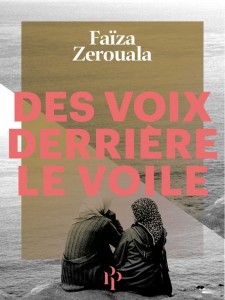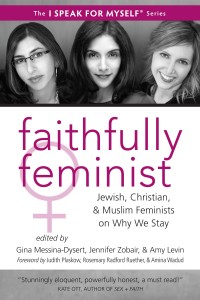“An identity neither begins nor ends on a stretch of land, for identity lives within the heart and consciousness. Land erodes, land evolves; it is plundered, and it is cultivated. It is not the master of its destiny. An identity is elusive; it can be neither contained nor defined by standards other than its own. Encompassing, defiant, and alive, the American Muslim identity is that of the ocean, its waves washing over diverse shores and merging their remnants into one entity” Hadia Mubarak
This is an excerpt from just one of the many narratives written by American Muslim women in “I Speak for Myself.” But this one quote expresses in few words what this collection of narratives expresses in volumes of intimate stories rarely told by American Muslim women.
 Put together by Maria Ebrahimji and Zahra Suratwala, “I Speak for Myself” is perhaps the most comprehensive collection of narratives from American-born Muslim women to date and includes the voices of MMW’s own founder and Editor-in-Chief, Fatemeh Fakhraie, as well as MMW contributor Yusra Tekbali.
Put together by Maria Ebrahimji and Zahra Suratwala, “I Speak for Myself” is perhaps the most comprehensive collection of narratives from American-born Muslim women to date and includes the voices of MMW’s own founder and Editor-in-Chief, Fatemeh Fakhraie, as well as MMW contributor Yusra Tekbali.
Speaking in the first person, the women in this book represent a cornucopia of ethnic backgrounds, including the overlooked Turkish Muslim woman, and often marginalized African-American Muslim women.
These women are not only varied in their ethnic backgrounds, but embody the diversity of American Muslim women in their professional capacities, as journalists, politicians, lawyers, doctors, designers, photographers, news reporters and activists as well as in their marital statuses, choice of dress, and beliefs and practices, extending to give glimpses of different sects, such as Shi’a, Sunni and Ismaili.
The only group that has been overlooked is the convert American Muslim woman. This is definitely a loss—the American Muslim women converts add to the diversity and richness of Islam in the U.S.
However, this book delivers on its intent to paint a broad yet intimate picture of American Muslim women, and does so through their voices and their stories, rather than through the perceptions of someone else.
As I progressed through the narratives of its pages, the most intimate stories stuck out among the rest and they expressed common themes.
Perhaps put most intimately by Fatemeh is the theme of longing for the country of our parents as a means to getting closer to our identity. She writes,
“Searching for himself and a better life drew Baba away from the Islamic Republic of Iran; searching for myself and my roots draws me nearer to it. Yet in reality, it is not the republic I am drawn to. Rather, I am trying to get nearer to my father through this land where my ancestors are buried.”
Other reoccurring themes include birth names, balancing hyphenated identities, the need to be validated by both Americans and Muslims and, of course, hijab.
While these themes seem to be woven, to some extent, into each narrative, the narratives themselves are varied in scope.
Some women chose to use experiences within their professional lives to tell their story: Rashida Tlaib speaks about walking the campaign trail as she became the first Muslim woman elected to the Michigan legislature. Sarah Pashtoon Azad painted a beautiful picture of what it is like to be in the operating room and how this daily experience impacts her outlook on life. Yusra Tekbali spoke about being Arab-American on Capitol Hill and her hope for a future where questions aren’t riddled with assumptions.
Others choose to keep it very personal, making their narrative seem as if it was ripped from the pages of their diary. Maytha Alhassen speaks about the “traveling surah” and how its incorporation into her family’s traditions always became a point of reference for her, bringing her back to her “religious point of departure.” Saliqa Khan speaks very frankly about her divorce and the constant need for her to find validation of her decision in her religion.
Still others choose to speak to their specific ethnicity, giving us a glance into the complex relationship woven between national, ethnic and communal identities. The most pleasant ethnic representation in the book comes from a handful of African-American Muslim women. Their stories are rarely heard and are often overlooked. Their inclusion in this collection speaks directly to the need for African-American Muslim voices to be heard and accepted as a part of the broader discourse of the American Muslim community.
Kameelah Janan Rasheed beautifully describes her experience as an African-American Muslim, writing,
“As a black Muslim woman in America, I am a run-on sentence that others constantly try to edit. Self-proclaimed editors take their pens to me as they would to a manuscript: erasing and marking…I footnoted elements of my Muslim identity to feel more accepted among black folks. I arrested elements of my blackness inside of the shield of parentheses to appease non-black Muslims…My self-editing was only reified by the external editing. I did not hate myself; rather, I hated that my self had been edited out of the public discourse.”
Through these narratives, it is quite clear that many American Muslim women dwell in an intermediate cultural borderland in which nostalgia and reality are shared. Our transitional characteristics inhabit a social and cultural milieu that is neither exclusively a certain ethnicity nor exclusively American, while amalgamating the contemporary realities of both. All the while, we exhibit a constant struggle of distancing ourselves from the traditions of our parents yet striving to hold onto them.
This book represents both a collective voice and a collection of individual and distinct voices. Though reoccurring themes litter its pages, “I Speak for Myself” allows its readers to hear the distinct voices of each of individual American Muslim woman as she speaks for herself.
I Speak for Myself is in U.S. bookstores today! Pick it up or grab it on Amazon.













